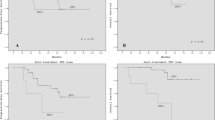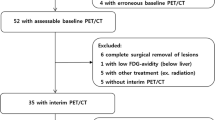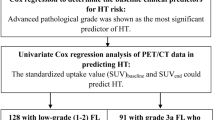Abstract
Purpose/objective(s)
To evaluate the impact of positron emission tomography (PET) staging on overall survival (OS) and progression-free survival (PFS) in patients with early-stage (stages I and II) follicular lymphoma (ESFL) treated with radiation therapy alone.
Materials/methods
Eighty-five patients with ESFL treated with curative-intent radiation therapy (RT) between December 2000 and May 2011 were identified. Of those, 13 who had no PET staging and 25 who received additional systemic therapy were excluded from the analysis. Thus, we analyzed 47 patients with PET-staged ESFL treated with definitive radiation therapy alone (dose > 23Gy). Tumour features, pre-treatment computed tomography (CT) and PET stage, dose fractionation, and radiation therapy field extent were recorded. The Kaplan–Meier method was used to estimate the OS and PFS. Patterns of failure were assessed as cumulative incidences assuming competing risks.
Results
Median age was 57 years (range 24–83); 43% were females. Most were PET stage 1 (76.6%). Median maximum nodal diameter was 3 cm. Median pre-treatment lactate dehydrogenase (LDH) was 327.5 (range 123–607, upper normal limit = 220). Twenty-six patients (55.3%) had infra-diaphragmatic disease. All received 30–36Gy in 15–24 fractions, with 59.6% treated with involved-field radiation therapy (IFRT) techniques. There was no significant difference in PFS between CT stage I and stage II (HR 1.30 95% CI [0.25–6.72], p = 0.75) with a 5-year PFS of 77% and 78% respectively. However, stage I on PET staging had a significantly better PFS than stage II (HR 4.66 95% CI [1.15–18.8], p = 0.038), with 5-year PFS of 84% and 60% respectively. Ten patients had recurrent disease, with distant disease being the first site of failure in seven patients. Seven-year OS was 91% (95% CI 79–100) for the whole cohort.
Conclusion
FDG-PET should be considered an essential element in the evaluation of patients with ESFL being considered for RT.

Similar content being viewed by others
References
Muller AM, Ihorst G, Mertelsmann R, Engelhardt M. Epidemiology of non-Hodgkin’s lymphoma (NHL): trends, geographic distribution, and etiology. Ann Hematol. 2005;84:1–12.
Tsang RW, Gospodarowicz MK. Radiation therapy for localized low-grade non-Hodgkin’s lymphomas. Hematol Oncol. 2005;23:10–7.
Pugh TJ, Ballonoff A, Newman F, Rabinovitch R. Improved survival in patients with early stage low-grade follicular lymphoma treated with radiation: a surveillance, epidemiology, and end results database analysis. Cancer. 2010;116:3843–51.
Mac Manus MP, Hoppe RT. Is radiotherapy curative for stage I and II low-grade follicular lymphoma? Results of a long-term follow-up study of patients treated at Stanford University. J Clin Oncol. 1996;14:1282–90.
Guadagnolo BA, Li S, Neuberg D, Ng A, Hua L, Silver B, et al. Long-term outcome and mortality trends in early-stage, grade 1–2 follicular lymphoma treated with radiation therapy. Int J Radiat Oncol Biol Phys. 2006;64:928–34.
Campbell JK, Matthews JP, Seymour JF, Wolf MM, Juneja SK. Australasian Leukaemia lymphoma G. Optimum trephine length in the assessment of bone marrow involvement in patients with diffuse large cell lymphoma. Ann Oncol. 2003;14:273–6.
Jerusalem G, Beguin Y, Najjar F, Hustinx R, Fassotte MF, Rigo P, et al. Positron emission tomography (PET) with 18F-fluorodeoxyglucose (18F-FDG) for the staging of low-grade non-Hodgkin’s lymphoma (NHL). Ann Oncol. 2001;12:825–30.
Wirth A, Foo M, Seymour JF, Macmanus MP, Hicks RJ. Impact of [18f] fluorodeoxyglucose positron emission tomography on staging and management of early-stage follicular non-hodgkin lymphoma. Int J Radiat Oncol Biol Phys. 2008;71:213–9.
Specht L. 2-[18F]fluoro-2-deoxyglucose positron-emission tomography in staging, response evaluation, and treatment planning of lymphomas. Semin Radiat Oncol. 2007;17:190–7.
Sasaki M, Kuwabara Y, Koga H, Nakagawa M, Chen T, Kaneko K, et al. Clinical impact of whole body FDG-PET on the staging and therapeutic decision making for malignant lymphoma. Ann Nucl Med. 2002;16:337–45.
Schoder H, Meta J, Yap C, Ariannejad M, Rao J, Phelps ME, et al. Effect of whole-body (18)F-FDG PET imaging on clinical staging and management of patients with malignant lymphoma. J Nucl Med. 2001;42:1139–43.
Denham J, Denham E, Dear K, Hudson G. The follicular non-Hodgkin’s lymphomas—I. The possibility of cure. Eur J Cancer. 1996;32:470–9.
Wilder RB, Jones D, Tucker SL, Fuller LM, Ha CS, McLaughlin P, et al. Long-term results with radiotherapy for stage I–II follicular lymphomas. Int J Radiat Oncol Biol Phys. 2001;51:1219–27.
Gospodarowicz MK, Bush RS, Brown TC, Chua T. Prognostic factors in nodular lymphomas: a multivariate analysis based on the Princess Margaret Hospital experience. Int J Radiat Oncol Biol Phys. 1984;10:489–97.
Pendlebury S, el Awadi M, Ashley S, Brada M, Horwich A. Radiotherapy results in early stage low grade nodal non-Hodgkin’s lymphoma. Radiother Oncol. 1995;36:167–71.
Denham J, Denham E, Dear K, Hudson G. The follicular non-Hodgkin’s lymphomas—II. Prognostic factors: what do they mean? Eur J Cancer. 1996;32:480–90.
Mac Manus MP, Bowie CAR, Hoppe RT. What is the prognosis for patients who relapse after primary radiation therapy for early-stage low-grade follicular lymphoma? Int J Radiat Oncol Biol Phys. 1998;42:365–71.
Bentur OS, Gurion R, Gafter-Gvili A, Gatt M, Shvidel L, Horowitz NA, et al. Treatment and prognosis of stage I follicular lymphoma in the modern era — does PET matter? Leuk Lymphoma. 2017;59(5):1163–71.
Ahmed N, Owen TE, Rubinger M, Williams G, Nugent Z, Ahmed S, et al. Early stage W.H.O. Grade I and II follicular lymphoma treated with radiation therapy alone. PLoS One. 2013;8:e65156.
Barrington SF, Mikhaeel NG, Kostakoglu L, Meignan M, Hutchings M, Mueller SP, et al. Role of imaging in the staging and response assessment of lymphoma: consensus of the international conference on malignant lymphomas imaging working group. J Clin Oncol. 2014;32:3048–58.
Stumpe K, Urbinelli M, Steinert H, Glanzmann C, Buck A, Von Schulthess G. Whole-body positron emission tomography using fluorodeoxyglucose for staging of lymphoma: effectiveness and comparison with computed tomography. Eur J Nucl Med Mol Imaging. 1998;25:721–8.
Wöhrer S, Jaeger U, Kletter K, Becherer A, Hauswirth A, Turetschek K, et al. 18F-fluoro-deoxy-glucose positron emission tomography (18F-FDG-PET) visualizes follicular lymphoma irrespective of grading. Ann Oncol. 2006;17:780–4.
Metser U, Dudebout J, Baetz T, Hodgson DC, Langer DL, MacCrostie P, et al. [18 F]-FDG PET/CT in the staging and management of indolent lymphoma: a prospective multicenter PET registry study. Cancer. 2017;123:2860–6.
Friedberg JW, Byrtek M, Link BK, Flowers C, Taylor M, Hainsworth J, et al. Effectiveness of first-line management strategies for stage I follicular lymphoma: analysis of the National LymphoCare Study. J Clin Oncol. 2012;30(27):3368-75.
Hany TF, Steinert HC, Goerres GW, Buck A, von Schulthess GK. PET diagnostic accuracy: improvement with in-line PET-CT system: initial results. Radiology. 2002;225:575–81.
Martinez MJ, Bercier Y, Schwaiger M, Ziegler SI. PET/CT biograph sensation 16. Performance improvement using faster electronics. Nuklearmedizin. 2006;45:126–33.
Marcus R, Imrie K, Belch A, Cunningham D, Flores E, Catalano J, et al. CVP chemotherapy plus rituximab compared with CVP as first-line treatment for advanced follicular lymphoma. Blood. 2005;105:1417–23.
Fisher RI, LeBlanc M, Press OW, Maloney DG, Unger JM, Miller TP. New treatment options have changed the survival of patients with follicular lymphoma. J Clin Oncol: Off J Am Soc Clin Oncol. 2005;23:8447–52.
Janikova A, Bortlicek Z, Campr V, Kopalova N, Benesova K, Belada D, et al. Radiotherapy with rituximab may be better than radiotherapy alone in first-line treatment of early-stage follicular lymphoma: is it time to change the standard strategy? Leukemia Lymphoma. 2015;56:2350–6.
MacManus MPFR, Roos D, O’Brien P, Macann AMJ, Christie D, Tsang RW, et al. Treatment with 6 cycles of CVP or R-CVP after involved field radiation therapy (IFRT) significantly improves progression-free survival compared to IFRT alone in stage I-II low grade follicular lymphoma: results of an international randomized trial. Int J Radiat Oncol Biol Phys. 2016;96:938.
Author information
Authors and Affiliations
Corresponding author
Ethics declarations
Conflict of interest
Authors Sweet Ping Ng, Richard Khor, Mathias Bressel, Michael MacManus, John F Seymour, Rodney J. Hicks, and Andrew Wirth declare that they have no conflict of interest. Sweet Ping Ng is funded by the Australian Postgraduate Award, Radiological Society of North America (RSNA) Fellow Grant, and Royal Australian and New Zealand College of Radiologists (RANZCR) Research Grant. Professor Hicks is supported by an Australian National Health and Medical Research Council Practitioner Fellowship.
Ethical approval
All procedures performed in studies involving human participants were in accordance with the ethical standards of the institutional research committee and with the 1964 Helsinki Declaration and its later amendments or comparable ethical standards.
This article does not contain any studies with human participants or animals performed by any of the authors.
Rights and permissions
About this article
Cite this article
Ng, S.P., Khor, R., Bressel, M. et al. Outcome of patients with early-stage follicular lymphoma staged with 18F-Fluorodeoxyglucose (FDG) positron emission tomography (PET) and treated with radiotherapy alone. Eur J Nucl Med Mol Imaging 46, 80–86 (2019). https://doi.org/10.1007/s00259-018-4112-2
Received:
Accepted:
Published:
Issue Date:
DOI: https://doi.org/10.1007/s00259-018-4112-2




